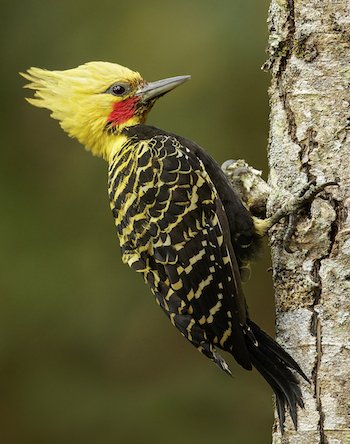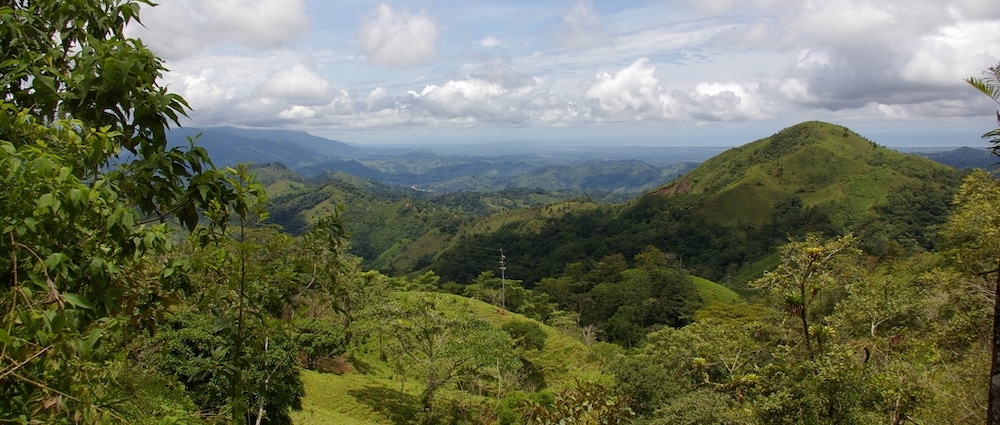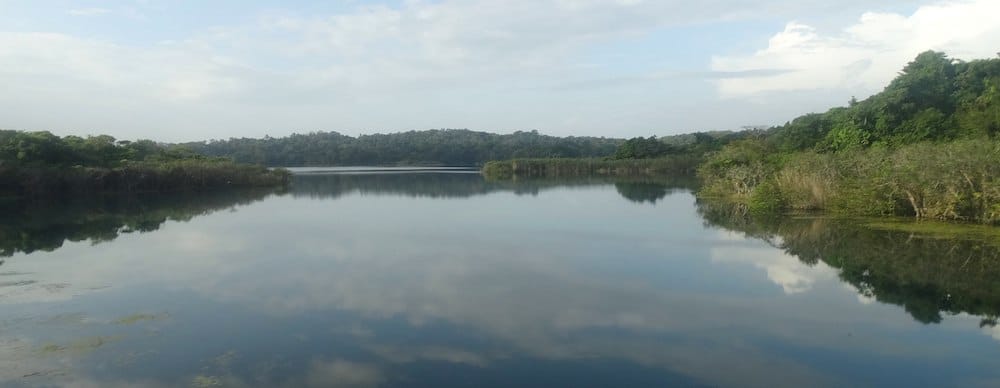Central America

Central America is a sub-region of North America. Its political boundaries are defined as bordering Mexico to the north, Colombia to the south, the Caribbean Sea to the east, and the Pacific Ocean to the west. Central America is usually defined as consisting of seven countries: Belize, Costa Rica, El Salvador, Guatemala, Honduras, Nicaragua, and Panama. Within Central America is the Mesoamerican biodiversity hotspot, which extends from northern Guatemala to central Panama. Due to the presence of several active geologic faults and the Central America Volcanic Arc, there is a high amount of seismic activity in the region, such as volcanic eruptions and earthquakes. The Caribbean is also a sub-region of the Americas that includes the Caribbean Sea and its islands, some of which are surrounded by the Caribbean Sea and some of which border both the Caribbean Sea and the North Atlantic Ocean; the nearby coastal areas on the mainland are sometimes also included in the region. The region is south-east of the Gulf of Mexico and Northern America, east of Central America, and north of South America.
Situated largely on the Caribbean Plate, the region has more than 700 islands, islets, reefs, and cays. Island arcs delineate the northern and eastern edges of the Caribbean Sea: the Greater Antilles in the north and the Lesser Antilles, which includes the Leeward Antilles, in the east and south. The nearby Lucayan Archipelago, comprising The Bahamas and the Turks and Caicos Islands, is considered to be a part of the Caribbean despite not bordering the Caribbean Sea. All the islands in the Antilles plus the Lucayan Archipelago form the West Indies, which is often interchangeable with the term Caribbean. On the mainland, Belize, the eastern and northern coasts of Central and South American countries such as the Bay Islands Department of Honduras, the North and South Caribbean Autonomous Regions of Nicaragua, the Limón Province of Costa Rica, and the Archipelago of San Andrés, Providencia and Santa Catalina of Colombia are also considered culturally Caribbean.
The geography and climate in the region varies: Some islands in the region have relatively flat terrain of non-volcanic origin. These islands include Aruba (possessing only minor volcanic features), Curaçao, Barbados, Bonaire, the Cayman Islands, Saint Croix, the Bahamas, and Antigua. Others possess rugged towering mountain-ranges like the islands of Saint Martin, Cuba, Hispaniola, Puerto Rico, Jamaica, Dominica, Montserrat, Saba, Sint Eustatius, Saint Kitts, Saint Lucia, Saint Thomas, Saint John, Tortola, Grenada, Saint Vincent, Guadeloupe, Martinique and Trinidad and Tobago.
Definitions of the terms Greater Antilles and Lesser Antilles often vary. The Virgin Islands as part of the Puerto Rican bank are sometimes included with the Greater Antilles. The term Lesser Antilles is often used to define an island arc that includes Grenada but excludes Trinidad and Tobago and the Leeward Antilles.
The waters of the Caribbean Sea host large, migratory schools of fish, turtles, and coral reef formations. The Puerto Rico Trench, located on the fringe of the Atlantic Ocean and Caribbean Sea just to the north of the island of Puerto Rico, is the deepest point in all of the Atlantic Ocean.
The climate of the whole area is tropical, varying from tropical rainforest in some areas to tropical monsoon and tropical savanna in others. There are also some locations that are arid climates with considerable drought in some years, and the peaks of mountains tend to have cooler temperate climates.
Rainfall varies with elevation, size and water currents, such as the cool upwellings that keep the ABC islands arid. Warm, moist trade winds blow consistently from the east, creating both rain forest and semi-arid climates across the region.

Costa Rican Forest ©Nao Iizuka, CC BY 3.0 via Wikimedia Commons
The tropical rainforest climates include lowland areas near the Caribbean Sea from Costa Rica north to Belize, as well as the Dominican Republic and Puerto Rico, while the more seasonal dry tropical savanna climates are found in Cuba. Arid climates are found along the extreme northern coast of Venezuela out to the islands including Aruba and Curacao. Hurricane season is from June to November, but they occur more frequently in August and September and more common in the northern islands of the Caribbean. Hurricanes that sometimes batter the region usually strike northwards of Grenada and to the west of Barbados. The principal hurricane belt arcs to northwest of the island of Barbados in the Eastern Caribbean.
Central America is a part of North America consisting of a tapering isthmus running from the southern extent of Mexico to the northwestern portion of South America. Central America has the Gulf of Mexico, a body of water within the Atlantic Ocean, to the north; the Caribbean Sea, also part of the Atlantic Ocean, to the northeast; and the Pacific Ocean to the southwest. Some physiographists define the Isthmus of Tehuantepec as the northern geographic border of Central America, while others use the northwestern borders of Belize and Guatemala. From there, the Central American land mass extends south-eastward to the Atrato River, where it connects to the Pacific Lowlands in northwestern South America.
Of the many mountain ranges within Central America, the longest are the Sierra Madre de Chiapas, the Cordillera Isabelia and the Cordillera de Talamanca. At 4,220 meters (13,850 ft), Volcán Tajumulco is the highest peak in Central America. Between the mountain ranges lie fertile valleys that are suitable for the raising of livestock and for the production of coffee, tobacco, beans and other crops. Most of the population of Honduras, Costa Rica and Guatemala lives in valleys.

Panama ©Adam Jones, CC BY-SA 2 via Wikimedia Commons
Trade winds have a significant effect upon the climate of Central America. Temperatures there are highest just prior to the summer wet season, and are lowest during the winter dry season, when trade winds contribute to a cooler climate. The highest temperatures occur in April, due to higher levels of sunlight, lower cloud cover and a decrease in trade winds.
Birding Central America & the Caribbean
I have been lucky enough to visit Trinidad & Tobago, Panama, Cayman Isles, Cuba and Jamaica in this region and found some of the best birding anywhere!
Costa Rica has an economy geared to tourism so has managed to rise far up everyone’s list of birding destinations, not just because it has a very long list of very beautiful birds but also because it is a small country with many different avifaunal regions with a first-class infrastructure, comfortable ‘western grade’ ecolodges and a larger proportion of its land protected than anywhere else. Some of the rest of the isthmus would, no doubt, be just as popular if those countries were better known to birders. (Unfortunately some have a reputation as being unsafe but most are on a par with most nations)., For example, Panama is less feted, but has a list of nearly 1000 bird species and shares many of these with its more famous neighbour. Moreover, it is the fastest growing economy in Latin America and its good infrastructure and growing number of eco-lodges (such as Canopy Tower voted one of the top 50 eco-lodges in the world!) making it a terrific destination. I stayed at the Canopy Tower and at the equally well located (and certainly more luxurious) Canopy Lodge and have no hesitation in recommending them. It is also regarded as being as safe or safer than Costa Rica and devotes even more of its country (37%) to National Parks and other areas of conservation.
I found the people helpful and friendly and we fell in love with its beautiful wild areas. The birding was terrific and there is more to discover as it too has distinct eco-regions with different avifauna that certainly warrant re-visiting. A photographer I met rated it as better than Costa Rica for photo-opportunities and liked the fact that it isn’t yet swamped with eco-tourists.
The Islands of the Caribbean are not just tropical paradises but many are home to large numbers of endemics in relatively small geographical areas. Cuba and Jamaica each have more than 30 endemics and are increasingly popular birding destinations often allowing non-birding partners to relax on palm-fringed beaches while the birder can clock up lifers. Cuba seems locked in the 1950’s in many ways and has the world’s smallest bird (Bee Hummingbird) and the barely explored Zapata Swamps which might yet turn up hidden species. While Jamaica offers up 90% of its endemics to your hotel’s poolside lounger or ornamental gardens.
Bridging two continents; central America shares many migratory birds with both and must be a wonderful place to be at such times. I saw more ‘wood warblers’ in Panama than in all my visits to their summer homes in the north, indeed, I have never seen Canada Warbler in Canada, but did so several times in Panama!
Trinidad and Tobago can certainly be recommended as a birding destination and it is easy to explore the islands from few bases as almost anywhere can be reached in an hour or two. The lurid local newspaper reports of crime may be a bit intimidating but it is generally safe for tourist and offers terrific birds as the Caribbean meets the avi-fauna of South America. Few birding experiences can rival a sunset watching hundreds Scarlet Ibis join half a dozen species of heron in their hundreds too coming to roost in Caroni Swamp, festooning the mangroves like baubles on Christmas trees.
In case your grasp geography is even worse than mine… Mexico and Bermuda can be found on the North American pages.

-
A Birder's West Indies
| (An Island-by-Island Tour) | By Roland H Wauer | University of Texas Press | 1996 | Paperback | 238 pages, 19 colour photos, illustrations, 2 maps, 1 table | Out of Print | ISBN: 9780292791015 Buy this book from NHBS.com -
A Guide to the Birds of Mexico and Northern Central America
| By Steve NG Howell & Sophie Webb| Oxford University Press | 1995 | 851 pages, 71 colour plates, 39 line drawings, 1087 maps | Out of Print | ISBN: 9780198540137 Buy this book from NHBS.com -
Birds of Central America
| (Belize, Guatemala, Honduras, El Salvador, Nicaragua, Costa Rica, and Panama) | By Andrew Vallely & Dale Dyer | Princeton University Press | 2018 | Paperback | 560 pages, 260 plates with colour illustrations; 1190+ colour distribution maps | ISBN: 9780691138022 Buy this book from NHBS.com -
Birds of Mexico and Central America
| By Ber Van Perlo | Princeton University Press | 2006 | Paperback | 336 pages, 98 plates with colour illustrations; b/w illustrations, b/w distribution maps, colour maps | ISBN: 9780691120706 Buy this book from NHBS.com -
Birds of the West Indies
| By Herbert Raffaele, James Wiley, Orlando Garrido, Allan Keith & Janis Raffaele | Helm | Edition 2 | 2020 | Flexibound | 288 pages, 129 colour plates, 181 colour distribution maps | ISBN: 9781472979506 Buy this book from NHBS.com -
Birds of the West Indies
| By Mike Flieg & Allan Sander | Bloomsbury Publishing | 2017 | Paperback | 144 pages, colour photos, 1 colour map | Out of Print | ISBN: 9781472938145 Buy this book from NHBS.com -
Birds of the West Indies
| Guy M Kirwan, Anthony Levesque, Mark W Oberle & Christopher J Sharpe | Lynx Edicions | 2019 | Flexibound | 400 Pages | 1600+ colour illustrations, 650+ colour distribution maps | ISBN: 9788416728176 Buy this book from NHBS.com -
Field Guide to Birds of the West Indies
| By Taryn Simon | Hatje Cantz | 2016 | Hardback | 606 pages, 367 b/w photos | ISBN: 9783775740920 Buy this book from NHBS.com -
Important Bird Areas in the Caribbean - Key Sites for Conservation
| By David C Wege & Veronica Anadon-Irizarry | BirdLife International | 2008 | Paperback | 348 pages, colour photos, illustrations, distribution maps, tables | ISBN: 9780946888658 Buy this book from NHBS.com -
Peterson Field Guide to Birds of Northern Central America - Belize, El Salvador, Guatemala, Honduras
| By Jesse Fagan & Oliver Komar | Houghton Mifflin Harcourt | 2016 | Paperback | 438 pages, 189 plates with colour illustrations; colour distribution maps | ISBN: 9780544373266 Buy this book from NHBS.com -
Peterson Field Guide to the Birds of Eastern and Central North America
| By Roger Tory Peterson | Houghton Mifflin Harcourt | Edition 7 | 2020 | Paperback | 392 pages, plates with colour illustrations; colour distribution maps | ISBN: 9781328771438 Buy this book from NHBS.com -
Raptors of Mexico and Central America
| By William S Clark | Princeton UP | 2017 | Hardback | 304 pages, 32 plates with colour illustrations; 213 colour photos, 3 b/w illustrations, 64 colour distribution maps | ISBN: 9780691116495 Buy this book from NHBS.com

Birds of the Caribbean
AndroidBirds of the Caribbean. It includes the birds of Grenada...
Birds of the West Indies
Apple iOS |Explore the vibrant Caribbean islands with Birds of the West Indies – your pocket guide to Caribbean birdwatching!Useful Information-
BirdPlanner.com
WebsiteBirdPlanner is a free site that enables you to generate bird lists for any place in the western hemisphere
Organisations-
BirdsCaribbean
WebsiteThe Caribbean is home to over 500 species of bird, including 172 species that are endemic to the region and found nowhere else in the world. In fact, there are over 100 bird species in the Caribbean that only live on one island. Overall, 59% of the resident birds—the ones that don’t migrate—in the region are endemic. The abundance of endemic species is one reason why the region is considered a biodiversity hotspot, and why conservation in the region is so important. -
Nature Conservancy in the Caribbean
WebsiteProtecting nature’s beauty and biodiversity throughout this paradise of islands and sea -
Optics for the tropics
WebsiteOptics for the Tropics builds capacity for bird conservation in the western hemisphere by providing quality binoculars for ornithologists in the Caribbean and Latin America. Binoculars are used for monitoring, research and education.
Guides & Tour Operators-
Birding Ecotours
Tour OperatorCustom-made and set itineraries to Latin America… -
Ecocolors
Tour OperatorThis unique eco-tour is specially design for bird watchers. We will be able to visit the main protected areas in the Yucatan peninsula such as Sianka`an, Holbox, Coba, and El Eden, as well as Guatemala and Belize rainforest. Mexico has around 1,040 different bird species, just in the Yucatan peninsula there are 509 different species in 62 families, from which 12 are endemic, with 4 subspecies, 2 morphos and 14 hipotetical registers. Belize and Guatemala have also more than 550 species of birds. -
Lost World Adventures
Tour OperatorLost World Adventures arranges specialised tours and expeditions in South America and other exotic New World destinations. Our company was founded in 1986, when we pioneered our first adventure trips into Venezuela. We now arrange travel throughout Latin America, including Belize, Guatemala, Honduras, Costa Rica, Panama, Ecuador and Galapagos Islands, Peru, Bolivia, Brazil, Chile and Argentina. -
Naturalist Journeys
Tour OperatorFounded in 1998 by owner and lead guide, Peg Abbott, we are a top nature and birding tour company. Our guides are naturalists, ornithologists, biologists, entomologists, geologists, photographers, artists, and more. Collectively, we treasure birding, nature, travel, good food, and good company ― our inspiration in designing unique travel opportunities. -
Rockjumper Birding Tours
Tour OperatorRockjumper Birding Tours is a dedicated bird tour company specializing in top-quality birdwatching holidays and wildlife safaris throughout the world, guided by passionate and experienced professional tour leaders.
Fatbirder - linking birders worldwide...
Skip to content
